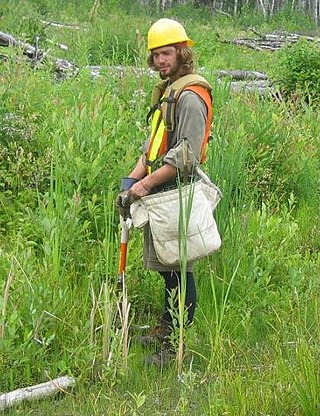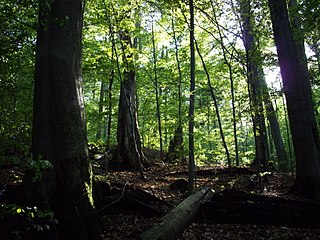
In ecology, an oasis is a fertile area of a desert or semi-desert environment that sustains plant life and provides habitat for animals. Surface water and land may be present, or water may only be accessible from wells or underground channels created by humans. In geography, an oasis may be a current or past rest stop on a transportation route, or less-than-verdant location that nonetheless provides access to underground water through deep wells created and maintained by humans.

The olive, botanical name Olea europaea, meaning 'European olive', is a species of small tree or shrub in the family Oleaceae, found traditionally in the Mediterranean Basin. When in shrub form, it is known as Olea europaea'Montra', dwarf olive, or little olive. The species is cultivated in all the countries of the Mediterranean, as well as in Australia, New Zealand, North and South America and South Africa. It is the type species for its genus, Olea. The tree and its fruit give their name to the Oleaceae plant family, which also includes species such as lilac, jasmine, forsythia, and the true ash tree.

Yggdrasil is an immense and central sacred tree in Norse cosmology. Around it exists all else, including the Nine Worlds.

An oak is a hardwood tree or shrub in the genus Quercus of the beech family. They have spirally arranged leaves, often with lobed edges, and a nut called an acorn, borne in a cup. The genus is widely distributed in the Northern Hemisphere; it includes some 500 species, both deciduous and evergreen. Fossil oaks date back to the Middle Eocene. Molecular phylogeny shows that the genus is divided into Old World and New World clades, but many oak species hybridise freely, making the genus's history difficult to resolve.

In graph theory, a tree is an undirected graph in which any two vertices are connected by exactly one path, or equivalently a connected acyclic undirected graph. A forest is an undirected graph in which any two vertices are connected by at most one path, or equivalently an acyclic undirected graph, or equivalently a disjoint union of trees.

In the fields of horticulture and botany, the term deciduous means "falling off at maturity" and "tending to fall off", in reference to trees and shrubs that seasonally shed leaves, usually in the autumn; to the shedding of petals, after flowering; and to the shedding of ripe fruit. The antonym of deciduous in the botanical sense is evergreen.

Tree planting is the process of transplanting tree seedlings, generally for forestry, land reclamation, or landscaping purposes. It differs from the transplantation of larger trees in arboriculture and from the lower-cost but slower and less reliable distribution of tree seeds. Trees contribute to their environment over long periods of time by providing oxygen, improving air quality, climate amelioration, conserving water, preserving soil, and supporting wildlife. During the process of photosynthesis, trees take in carbon dioxide and produce the oxygen we breathe.

The cherry blossom, or sakura, is the flower of trees in the genus Prunus or subgenus Cerasus. "Sakura" usually refers to flowers of ornamental cherry trees, such as cultivars of Prunus serrulata, not trees grown for their fruit. Cherry blossoms have been described as having a beautiful smell, and are often the inspiration for candles and incense.

Fagus sylvatica, the European beech or common beech is a large, graceful deciduous tree in the beech family with smooth silvery-gray bark, large leaf area, and a short trunk with low branches.

In the mathematical field of graph theory, a spanning treeT of an undirected graph G is a subgraph that is a tree which includes all of the vertices of G. In general, a graph may have several spanning trees, but a graph that is not connected will not contain a spanning tree. If all of the edges of G are also edges of a spanning tree T of G, then G is a tree and is identical to T.

The tree line is the edge of a habitat at which trees are capable of growing. It is found at high elevations and high latitudes. Beyond the tree line, trees cannot tolerate the environmental conditions. The tree line is sometimes distinguished from a lower timberline, which is the line below which trees form a forest with a closed canopy.

Hylidae is a wide-ranging family of frogs commonly referred to as "tree frogs and their allies". However, the hylids include a diversity of frog species, many of which do not live in trees, but are terrestrial or semiaquatic.

Gainesville-Hawthorne State Trail is a paved rail trail in Florida.

Acer is a genus of trees and shrubs commonly known as maples. The genus is placed in the soapberry family, Sapindaceae, along with lychee and horse chestnut. There are approximately 132 species, most of which are native to Asia, with a number also appearing in Europe, northern Africa, and North America. Only one species, Acer laurinum, extends to the Southern Hemisphere. The type species of the genus is the sycamore maple, Acer pseudoplatanus, the most common maple species in Europe. Maples usually have easily recognizable palmate leaves and distinctive winged fruits. The closest relatives of the maples are the horse chestnuts. Maple syrup is made from the sap of some maple species. It is one of the most common genera of trees in Asia. Many maple species are grown in gardens where they are valued for their autumn colour.

Ulmus serotinaSarg., the September elm, is an autumn-flowering North American species of tree. It is uncommon beyond Tennessee; it is only very locally distributed through Illinois, Kentucky, Arkansas, Mississippi, Oklahoma, Alabama, and Georgia, and disjunct populations into Nuevo León, Mexico. It grows predominantly on limestone bluffs and along streams to elevations of 400 m.

Boyd Big Tree Preserve Conservation Area is a 949.49-acre (384.24 ha) Pennsylvania state park in Lower Paxton and Middle Paxton Townships in Dauphin County, Pennsylvania. The land for the conservation area was donated to the state by real estate developer Alex Boyd in 1999. Boyd Big Tree Preserve Conservation Area is a sanctuary for mature trees and an environment education study area. The park is on Blue Mountain just off Pennsylvania Route 443.

Temperate deciduous or temperate broad-leaf forests are a variety of temperate forest 'dominated' by deciduous trees that lose their leaves each winter. They represent one of Earth's major biomes, making up 9.69% of global land area. These forests are found in areas with distinct seasonal variation that cycle through warm, moist summers, cold winters, and moderate fall and spring seasons. They are most commonly found in the Northern Hemisphere, with particularly large regions in eastern North America, East Asia, and a large portion of Europe, though smaller regions of temperate deciduous forests are also located in South America. Examples of trees typically growing in the Northern Hemisphere's deciduous forests include oak, maple, basswood, beech and elm, while in the Southern Hemisphere, trees of the genus Nothofagus dominate this type of forest. Temperate deciduous forests provide several unique ecosystem services, including habitats for diverse wildlife, and they face a set of natural and human-induced disturbances that regularly alter their structure.

The crown of a plant is the total of an individual plant's aboveground parts, including stems, leaves, and reproductive structures. A plant community canopy consists of one or more plant crowns growing in a given area.

In botany, a tree is a perennial plant with an elongated stem, or trunk, usually supporting branches and leaves. In some usages, the definition of a tree may be narrower, including only woody plants with secondary growth, plants that are usable as lumber or plants above a specified height. In wider definitions, the taller palms, tree ferns, bananas, and bamboos are also trees.

The Ulmus pumila cultivar 'Aurescens' was introduced by Georg Dieck at the National Arboretum, Zöschen, Germany, circa 1885. Dieck grew the tree from seed collected in the Ili valley, Turkestan by the lawyer and amateur naturalist Vladislav E. Niedzwiecki while in exile there. Dieck originally named the tree U. pinnato-ramosaf.aurescens.



















